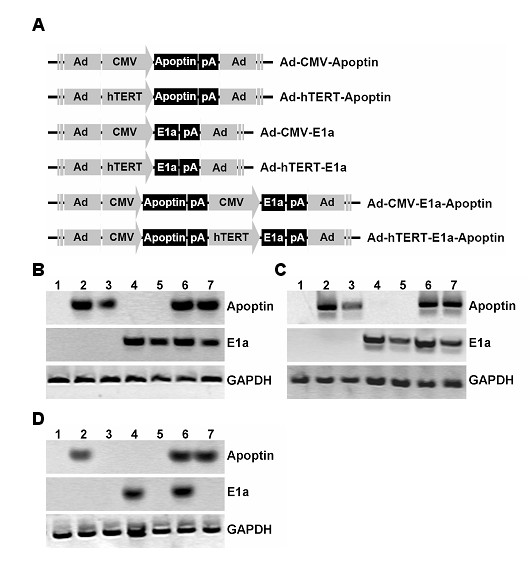Figure 1.

Schematic of the recombinant adenoviruses and the adenovirus-mediated transgene expression. (A) Schematic diagram depicting the organization elements in the recombinant adenoviruses. Polyadenylation signal sequence is designated as pA. The indicated cells were infected with Ad-mock (control) or indicated recombinant viruses at a MOI of 100 for 48 h. Western blot analysis was performed to detect (B) Apoptin or E1a protein from A375 cells, (C) Apoptin or E1a expression in B16 cells, or (D) Apoptin or E1a expression in HEM cells. Infection of normal HEM human epidermal melanocytes (D) with Ad-CMV-E1a or Ad-CMV-E1a-Apoptin, but not Ad-hTERT-E1a or Ad-hTERT-E1a-Apoptin, resulted in production of E1a proteins, whereas in A375 (B) and B16 (C) melanoma cells, infection with all these replication-competent recombinant adenoviruses generated E1a proteins. In HEM cells (D), infection with Ad-CMV-E1a-Apoptin and Ad-CMV-Apoptin resulted in Apoptin production, whereas infection with Ad-hTERT-Apoptin or Ad-hTERT-E1a-Apoptin resulted in barely detectable of Apoptin production. In A375 (B) and B16 (C) cells, infection with Ad-CMV-Apoptin, Ad-hTERT-Apoptin, Ad-CMV-E1a-Apoptin, or Ad-hTERT-E1a-Apoptin generated significant Apoptin production. 1. Ad-mock; 2. Ad-CMV-Apoptin; 3. Ad-hTERT-Apoptin; 4. Ad-CMV-E1a; 5. Ad-hTERT-E1a; 6. Ad-CMV-E1a-Apoptin; 7. Ad-hTERT-E1a-Apoptin.
